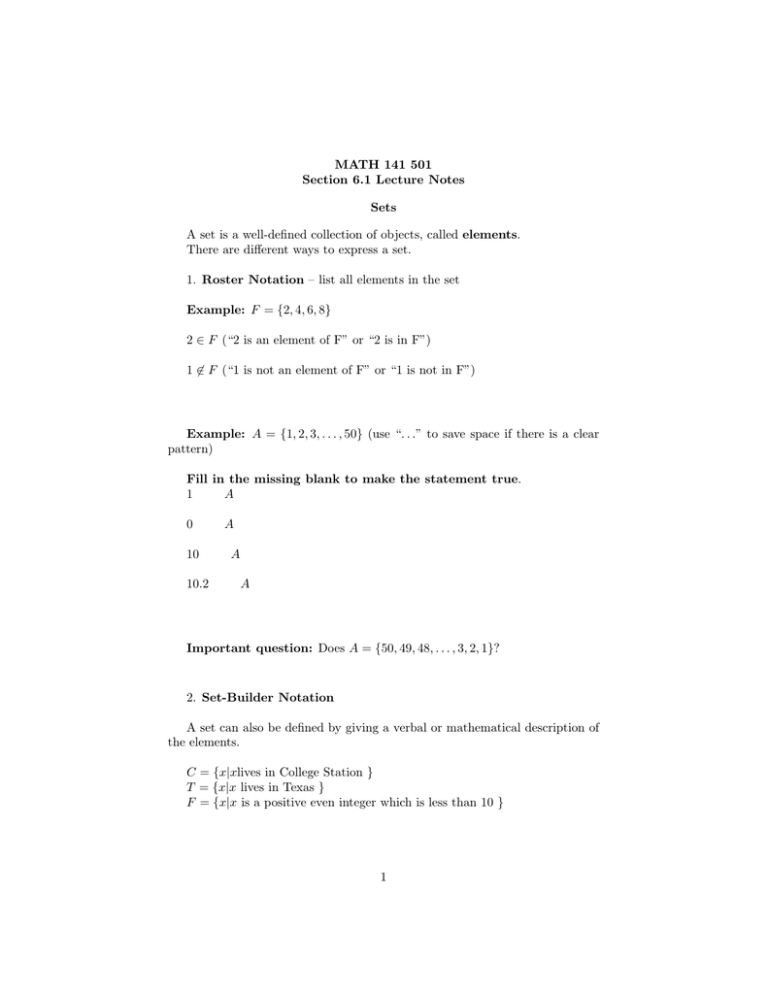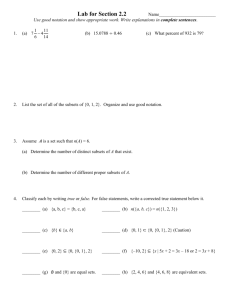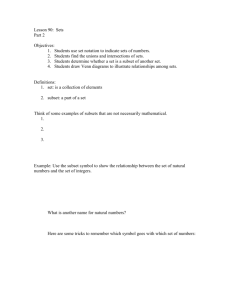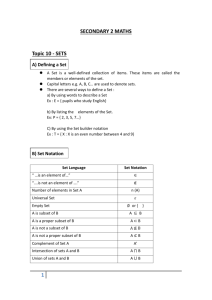MATH 141 501 Section 6.1 Lecture Notes Sets
advertisement

MATH 141 501
Section 6.1 Lecture Notes
Sets
A set is a well-defined collection of objects, called elements.
There are different ways to express a set.
1. Roster Notation – list all elements in the set
Example: F = {2, 4, 6, 8}
2 ∈ F (“2 is an element of F” or “2 is in F”)
1 6∈ F (“1 is not an element of F” or “1 is not in F”)
Example: A = {1, 2, 3, . . . , 50} (use “. . .” to save space if there is a clear
pattern)
Fill in the missing blank to make the statement true.
1
A
0
10
10.2
A
A
A
Important question: Does A = {50, 49, 48, . . . , 3, 2, 1}?
2. Set-Builder Notation
A set can also be defined by giving a verbal or mathematical description of
the elements.
C = {x|xlives in College Station }
T = {x|x lives in Texas }
F = {x|x is a positive even integer which is less than 10 }
1
Equality and Subsets
Subsets A is a subset of B if every element of A is also an element of B.
We write A ⊆ B to indicate that A is a subset of B.
Example: If A = {1, 2, 3} and B = {1, 2, 3, 4}, then A ⊆ B.
Proper Subsets A is a proper subset of B if A ⊆ B but A 6= B. In
words, A is a proper subset of B if A is a subset of B, but A and B are not the
same.
Example: A = {1, 2, 3}, B = {1, 2, 3, 4}. (same example as above). In this
case, A is a proper subset of B.
Note that any set is a subset of itself, but no set is a proper subset of itself.
Other Important Concepts
Empty Set: The empty set is the set which contains no elements. We
write ∅ to represent the empty set. The empty set is a subset of any set!
Universal set: The universal set is the set which contains all elements
of interest for a particular problem. All sets (in a given problem) are subsets of
the universal set (for that given problem.)
Note:
0=
{0} =
∅=
{∅} =
2
Venn Diagrams
Venn diagrams – a visual way of representing information about sets. The
universal set U is represented by a rectangle . Subsets are represented by circles
inside the rectangle.
Example: Draw a Venn diagram to represent the relationship between the
following sets.
U = {x|xis a person on Earth }
A = {x|x goes to college}
B = {x|xhas a job}
C = {x|x goes to Texas A & M}
3
Set Operations
Complement: The complement of a set A, denoted Ac , is the set of all
elements which are in U but not in A.
Example: If U is the set of all students at Texas A & M and A is the set
of Texas A & M football players, what is Ac ?
Intersection: The intersection of two sets A and B is the set of all elements which are in both A and B.
→ Notation: The intersection of A and B is written A ∩ B.
Example: If A = {1, 2, 3} and B = {3, 4, 5}, what is A ∩ B?
Example: If A = {x|x is a Texas A &M student }, B = {x|x is female },
and C = {x|x is a student-athlete at their university }, what is A ∩ B ∩ C?
Figure 1: A ∩ B
Figure 2: A ∩ B ∩ C
4
Two sets are disjoint if their intersection is the empty set (i.e. if they do
not have any elements in common.)
5
More Set Operations
Union: The union of two sets A and B is the set of all elements which are
in A, in B, or in both A And B.
Figure 3: A ∩ B
Figure 4: A ∩ B ∩ C
→ Notation: The union of A and B is written A ∪ B.
Example: If A = {1, 2, 3} and B = {3, 4, 5}, what is A ∪ B?
Figure 5: A ∪ B
Figure 6: A ∪ B ∪ C
de Morgan’s Laws are a “shortcut” which allow us to determine or describe
sets more quickly.
1. (A ∪ B)c = Ac ∩ B c
2. (A ∩ B)c = Ac ∪ B c
6
Example
Shade a Venn diagram to represent the following sets.
(a.) A ∪ B c ∪ C
(b.) (Ac ∪ B) ∩ C
(c.) (A ∪ B)c ∩ C c
7







